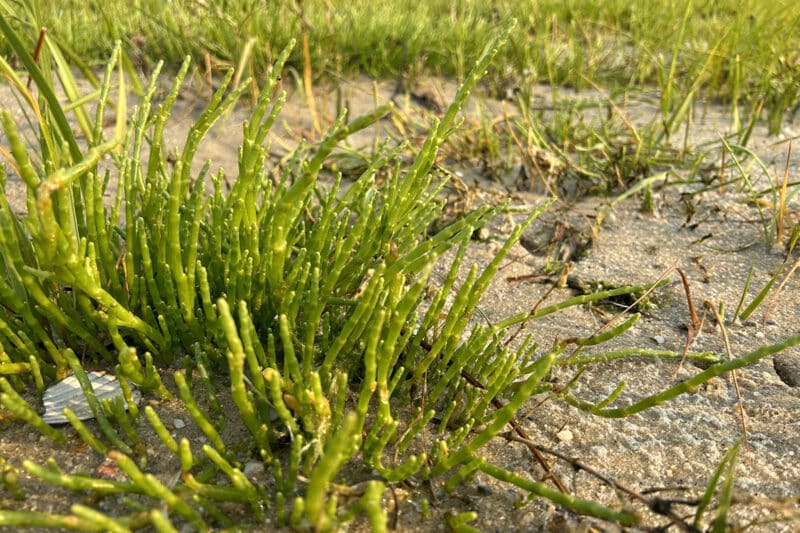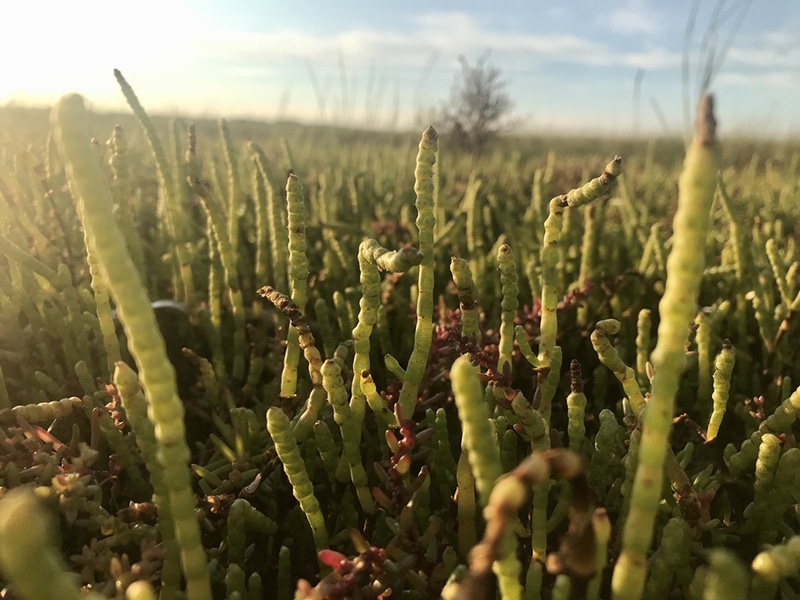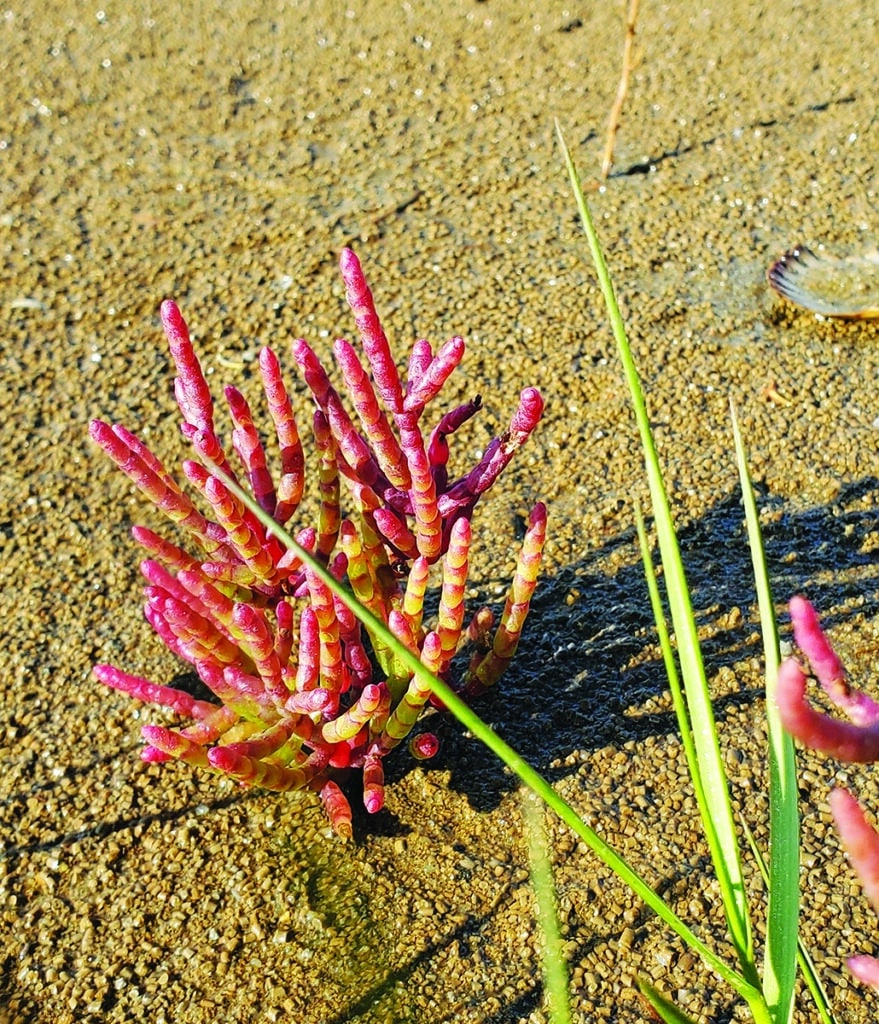by Dr. Sarah Treanor Bois, PhD
Director of Research & Education at the Linda Loring Nature Foundation
Chicken claws, sea beans, glasswort, sea asparagus—these are all common names for the same plant. With multiple species of glasswort worldwide, these plants are commonly called by their Latin genus, Salicornia. The word “salicornia” actually comes from the Greek “salt horn.” So maybe you can guess where we might find these plants?
The most common glasswort on Nantucket is Salicornia depressa, a small, annual herb typically of mudflats and saltmarshes that we can frequently find on the vegetated beaches of our harbors. Being that it is small and doesn’t have showy flowers or fruits, glasswort is often overlooked and underappreciated. But there are lots of reasons that this plant should be on your radar.
Salicornia plants look like small succulents without spikes. They have been described as having sausage-shaped stems, which is certainly true once you see some. Their simple or branched stems are succulent, hairless, and appear jointed. The opposite leaves are tiny and much reduced, looking like little scales along the fleshy stems. They are varying shades of green, but some can turn bright red in the fall, a rare fall foliage color on Nantucket and a treat to see on the beach!
There are multiple species of Salicornia on Nantucket. Salicornia depressa is the most common and typically what most people encounter. Salicornia bigelovii is dwarfed and less common. Salicornia perennis is a perennial glasswort and less frequently seen on-island. There are a few more, and the taxonomy is changing, but they have a lot of commonalities. They are physically similar to each other and occupy similar habitats, so are often lumped together collectively as Salicornia or by their preferred common name which varies regionally. Salicornia is known as glasswort, pickleweeds, or sea pickles. They are also sometimes called sea asparagus or sea beans, implying their edibility. In a 2016 article by the culinary institution James Beard Foundation, Salicornia was described as “nautical haricots verts.” It’s true that they are a delicious salty snack while walking along the beach or salt marsh edge. However, I think their saltiness lends itself better to a topping on a salad. They can be pickled, as the other common names imply. And their salty goodness has led them to be a fancy food item in some restaurants. Once described as “fishermen’s food,” this delicacy is becoming a trendy garnish in some gourmet establishments. Besides, Salicornia’s nutritional benefits make it a healthy alternative for salt.
Their edibility coupled with Salicornia’s ability to harvest fresh water from salt water environments makes Salicornia potentially useful as an agricultural commodity. It has been proposed that Salicornia production could be a good commodity in areas with limited freshwater. In an agricultural setting, Salicornia can be watered with saltwater thus eliminating the need for freshwater where limited.
There are very few species that can tolerate a salt-water environment. Most of us know that, generally, saltwater isn’t great for plants. However, if you’re a plant that can tolerate salt, there is a lot of available habitat. These halophytic (salt loving) plants have to figure out a way to deal with salt. For Salicornia, not only do they “deal” with the salt, but research has shown that various Salicornia grow much better when salt levels are high—they love it! Like all succulents, Salicornia have enlarged vacuoles that store water. However, these large vacuoles store more than just water. They also store salts, and lots of them. By concentrating salt in their vacuoles, Salicornia are ensuring that they are on the receiving end of the water gradient. Fresh water goes into the cells via osmosis while the salt is sequestered in the vacuoles. This allows Salicornia to occupy areas not available to other plants. It’s cool to think that the same adaptations cacti have for the desert, where there is little water, works for succulents that are surrounded by salt water, but are limited in the availability of fresh water.
Because Salicornia can occupy these harsh environments and are often the first to do so, they are considered a pioneer species of salt marsh systems. As pioneers, they help stabilize the sand or mud and deliver oxygen down through their roots, allowing other species to settle: sea lavender, sedges and grasses, for example, which also are halophytic (salt tolerant). The presence of these first plants on the developing saltmarsh will affect the physical conditions allowing other plants to colonize.
Salicornia is also one of the indicator species for saltmarsh, so seeing the plant categorizes that area as salt-marsh or at least a salt water environment. I find this interesting since we recently documented a small population along the banks of the north shore of Long Pond. We know this area to be brackish and expect with sea level rise that the salinity may increase over time, however this is the first salt-loving, halophytic species we have documented in this area. The surrounding species are primarily freshwater or brackish-tolerant. Maybe this small pioneering population of Salicornia is an indicator of changes to come.
Salicornia have a long history of human use as a food and in medicine. One of its common names, glasswort, was given to this resilient saltmarsh plant for it’s use to make glass. When burned, the dried ashes of Salicornia contain potash. Potash is potassium oxide which is used in soaps and glassmaking. In the 18th century, ash from incinerated glasswort was used in the manufacture of soda glass, prized for its crystal clear color.
One potential problem with consuming Salicornia from the wild these days is that, with all of the possible contaminants in the water, it may be wise to steer clear of direct harvesting from certain areas with known water quality issues. Alison Palmer, of UMASS Boston, has conducted research on the Salicornia of Nantucket. She specifically looked at Salicornia’s ability to accumulate toxins and its potential use as a bioremediation tool. When sequestering the salt in their vacuoles, other chemicals can also be sequestered. While not great for consumption, people are looking at Salicornia’s abilities as a way to remove pollutants, specifically heavy metals, from the environment—phytoremediation (plants used for bioremediation). Salicornia can help protect the saltmarshes they live in. On YouTube, you can watch a recording of Alison discussing her work at the UMASS Boston Nantucket Field Station: youtube.com/watch?v=ehMXyLQOKwo.
Salicornia is a very common salt marsh plant throughout New England, and the species is distributed worldwide. On Nantucket, we find it in pockets of vegetation on harbor beaches like Monomoy or the Creeks area off of Washington Street Extension. It is a common plant in salt marshes and is seen as a pioneer species of this habitat. So look for it next time you are out for a walk along the salt marsh edge, along the harbor flats, or the gentle shoreline of Polpis and Nantucket Harbors.





